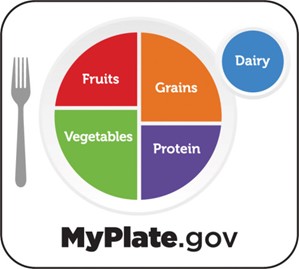
Research & Data Services
February 12-16, 2024
#LoveData24
Thursday, February 15, 2024 – Blog Post by Tiffany Grant, PhD, CDE
Today we will focus on diet and nutrition. Poor diet is a leading cause of cardiovascular disease, diabetes, and obesity. Over the last several decades consumption of processed foods and changing lifestyles have led to the development of unhealthy diets. The lockdowns of the pandemic and the increased use of remote technologies have also led to an increase in sedentary lifestyles and habits amplifying the impact of these already unhealthy lifestyles. Eating the right variety of foods in moderation can help to offset this impact and help to reduce the risk of cardiovascular disease and obesity.
What does a healthy diet look like?
The details of a “healthy diet varies for each person, but there are some common threads. Individuals should aim to incorporate nutrient-dense foods like vegetables, lean proteins, healthy fats, and high-fiber carbs and limit low-nutrient, high-calorie foods like sweets, fatty meats, and fried and processed foods.
All healthy eating plans should include:
- Fruits and vegetables
- Lean meats and plant-based sources of protein
- Less added sugar
- Less processed foods
MyPlate.gov
MyPlate is a visual reminder to make healthy choices from each of the five groups. MyPlate.gov offers tips and resources that support healthy dietary patterns.
For healthy recipe ideas, check out My Plate. The MyPlate Quiz is a quick self-assessment tool that provides tailored resources based on answers to a series of simple questions about current eating habits. The results page provides a snapshot of how the user is doing in meeting food group recommendations. The user can then sync quiz results with the Start Simple with MyPlate app to set daily goals organized by food group. Each goal can be personalized to personal preference, cultural foodways, and budget needs, and includes sample tips as starter ideas.
Check out this mini-poster for more information and tips on nutrition, including portion amounts for each dietary component.
Grocery Shopping Tips
First consider your shopping cart divided into fourths.
- Fill one half of your shopping cart with fruits and vegetables. These can be fresh, frozen, canned or dried. Start in the produce section to get more fresh produce.
- Fill one fourth of the cart with whole grains like bread, tortillas, pasta, brown rice, quinoa, etc.
- Fills one fourth with healthy proteins. This can include seafood and lean meats, but also nuts, nut butters, eggs and beans.
- Aim to add dairy to your cart. Milk/dairy provides essential vitamins like calcium and vitamin D that you are less likely to get from other foods in the same quantity that milk provides. Other sources of dairy can include, yogurt and cheese. Also, when reading your label, you may find that many sources of dairy are also great sources of protein!
Similarly, your grocery cart should look like your plate.
- Half plate of fruit and vegetables
- Quarter plate of lean protein
- Quarter plate of high-fiber carbohydrates

Nutrition Label Tips
Serving Size, Calories, and Macronutrients
- Check serving sizes first! They may not be the same as the usual portion you take or the amount you assume it is.
- A can of soup often has 2.5 “servings”, but a person often has 1 full can
- A bag of chips often has 3 “servings,” but a person often has 1 full bag
- Calories are good to check if you choose to look at just one part of the nutrition label
- Fat, carbohydrates, and protein are worth checking
Nutrients to increase
- Dietary fiber
- Calcium
- Potassium
- Vitamin D
Nutrients to decrease
- Saturated fat
- Sodium
- Added sugars
Ways to Use Nutrition Labels
- Guide to serving and portion sizes
- Compare two products to choose the healthier
- Limit or increase consumption of calories or certain nutrients
- Finding new foods that fit within your plan
List of Ingredients
- Listed from highest to lowest quantity in the food product
- Use it to find ingredients you may or may not want
- You might want:
- Whole grains
- Olive, soybean, or canola oil
- You may not want:
- Added sugars like honey, sugar, molasses, corn syrup, high fructose corn syrup, turbinado sugar, agave syrup, brown rice syrup
- Hydrogenated oil, partially hydrogenated oil
- Nitrites, sodium nitrate
- You can also check for preservatives, colors, flavors, and other types of additives
A great resource on reading food labels can be found here.
No material on this site is intended to be a substitute for professional medical advice, diagnosis or treatment. Always seek the advice of your physician or other qualified health care provider with any questions you may have regarding a medical condition or treatment and before undertaking a new health care regimen, and never disregard professional medical advice or delay in seeking it because of something you have read on this website.
References
